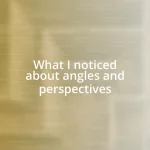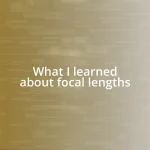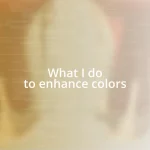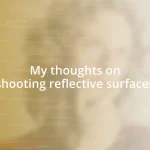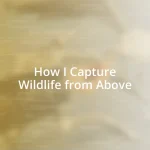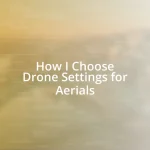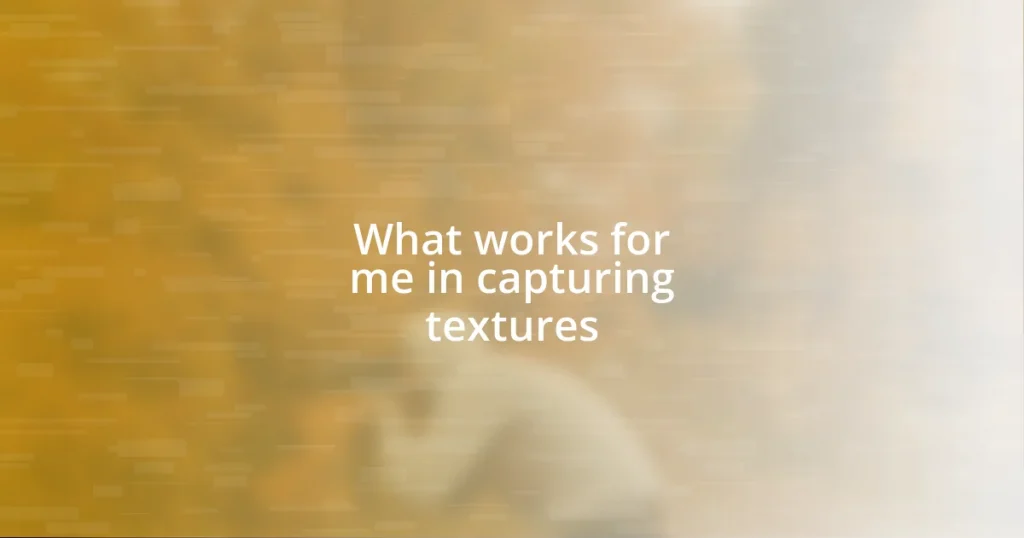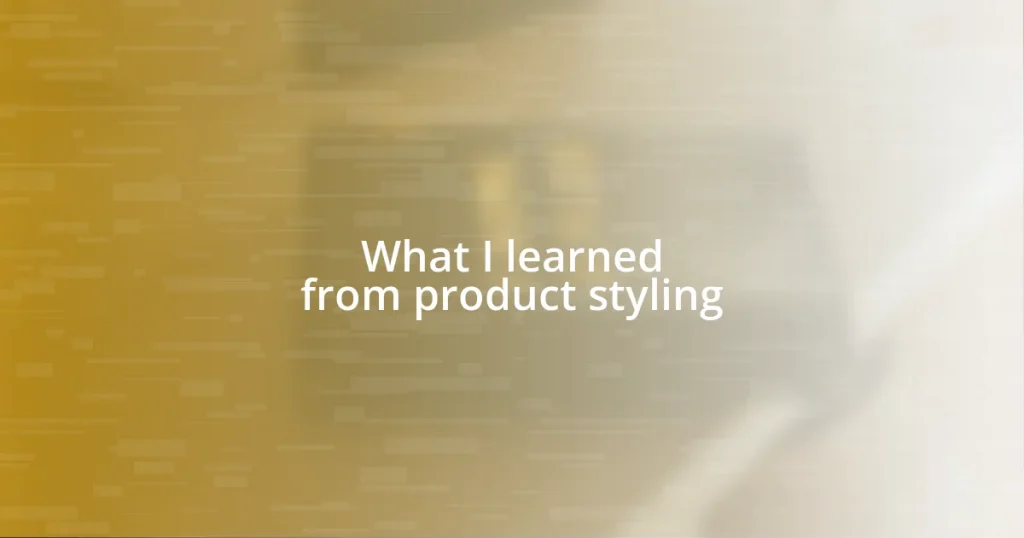Key takeaways:
- Aerial photography requires mastering camera settings, including shutter speed, aperture, and ISO, to enhance image quality.
- Choosing the right equipment and accessories, like drones and ND filters, is essential for achieving stable and high-quality aerial shots.
- Developing a unique photographic style involves experimentation, self-reflection, and focusing on elements like color, contrast, and storytelling in compositions.

Understanding Aerial Photography Basics
Aerial photography is all about perspective. I vividly remember the first time I captured a landscape from above; it felt like discovering an entirely new world. The textures and colors of the earth transformed beneath my drone. Have you ever experienced that sense of awe when viewing something from a height? That’s the magic of aerial photography!
Understanding the technical aspects is crucial. For instance, knowing how to adjust your camera settings for different altitudes makes a significant difference in image quality. When I first started, I often struggled with blurred images because I overlooked shutter speed and ISO settings. What about you—have you ever faced similar challenges while learning to adjust your gear?
Additionally, composition in the aerial realm brings its own unique considerations. It’s vital to think about leading lines, patterns, and the rule of thirds from above. I still remember a specific shot where I captured the winding river that beautifully framed the landscape. It’s moments like those that teach us: how do we find these elements in our own journeys? Looking at the world from above encourages us to see details we might miss from the ground.

Choosing the Right Equipment
Choosing the right equipment for aerial photography can feel overwhelming, but I’ve learned that it starts with understanding your needs. My first drone was a budget model, and while it opened the door to aerial photography, I quickly outgrew its limitations. When I finally invested in a higher-end drone, the difference in image stability and camera quality was like switching from a flip phone to the latest smartphone. What do you want to achieve with your aerial shots?
Camera choice is just as important. I initially thought any camera would suffice, but my experience taught me that sensor size and lens quality play significant roles in capturing stunning images. I remember transitioning from a basic DSLR to a mirrorless camera, and the sharpness of the images was breathtaking. Are you ready to explore how the right camera can elevate your work?
Another aspect worth considering is the accessories and software needed to complement your equipment. Gimbals and ND filters became essential tools in my gear bag, helping stabilize shots and control light exposure. I once forgot my ND filter on a particularly sunny day, and the resulting overexposed images served as a tough lesson. Have you thought about what accessories will enhance your aerial photography experience?
| Equipment | Key Features |
|---|---|
| Drone Model | Stability, Camera Quality, Range |
| Camera Type | Sensor Size, Lens Options, Weight |
| Accessories | Gimbals, ND Filters, Extra Batteries |

Mastering Camera Settings
Mastering camera settings is an essential step that defines the quality of your aerial photographs. I remember a day when I decided to experiment with manual settings during a golden sunset flight. The moment I adjusted the aperture to let in more light, my heart raced with excitement as the landscape transformed into a tapestry of colors. It felt like I was painting with light, and achieving that level of control over my images was a pivotal moment in my journey.
To truly capture the essence of aerial photography, it’s crucial to understand these key settings:
– Shutter Speed: Adjusts how long the sensor is exposed to light. Faster speeds help freeze motion, while slower speeds can create a dreamy effect.
– Aperture (f-stop): Controls the depth of field; lower numbers give blurred backgrounds, making your subject pop.
– ISO: Sensitivity to light; higher ISO means better low-light performance but can introduce noise.
– White Balance: Adjusts color temperature based on lighting conditions, crucial for accurate color reflection.
– Exposure Compensation: Useful for adjusting brightness, especially when shooting in tricky lighting situations.
Navigating these settings feels more like a dance than a chore. I often find myself in scenarios where I must quickly adapt. During one flight over a bustling city at midday, I experienced shifting light as clouds moved in and out. Adjusting my settings on-the-fly became second nature as I instinctively changed ISO and shutter speed to capture those fleeting moments. Each experience is a valuable lesson, shaping my expertise and helping me grow more comfortable with my camera’s capabilities. What settings have you been experimenting with in your own aerial photography adventures?

Techniques for Captivating Shots
Captivating shots in aerial photography often hinge on achieving the right angles. I vividly recall hovering my drone at a low altitude during a foggy morning, capturing the ethereal beauty of the world shrouded in mist. The angles made all the difference, turning an ordinary scene into a mysterious landscape that felt otherworldly. Have you felt that rush of excitement when you discover a unique perspective?
Another technique I find invaluable is understanding the play between foreground and background elements. I once juxtaposed a vibrant patch of wildflowers against vast mountain ranges in the distance, creating depth and richness in that frame. It’s all about storytelling through layers. How can you incorporate elements in your surroundings to add a narrative to your shots?
Finally, timing your shots is crucial. From golden hour to those fleeting moments during a storm, I’ve learned that beauty often lies in the most unexpected weather conditions. One of my most memorable images was captured in the midst of a light drizzle, where the rain droplets added an enchanting quality to the colors of the trees below. What weather conditions have you found to be surprisingly advantageous for your photography?

Post-Processing Your Images
Post-processing your images can truly elevate your aerial photography to new heights. I recall a late-night session spent refining an image from a vibrant sunset flight. As I carefully adjusted the contrast and saturation, the colors leaped off the screen, making that breathtaking view come alive again. Has anyone ever experienced the thrill of breathing new life into an image through editing?
One tool I find particularly powerful is Adobe Lightroom. It’s incredible how simple sliders can transform an image. I once used the clarity slider to enhance the details in a stunning mountain range shot. I felt a sense of satisfaction as I watched the layers of rock and vegetation pop, almost as if I was uncovering hidden secrets in my own work. Don’t you think there’s something wonderful about making a photograph look even more like how we remember the moment?
Save those images in a higher resolution to ensure they retain quality when printed or shared online. I learned this the hard way when a photo I was so proud of lost clarity due to resizing. Now, I take extra steps to maintain quality from the start, treating each image with the respect it deserves. What safeguards do you have in place to protect the integrity of your captured moments?

Developing Your Style
Finding your unique style in aerial photography is a fascinating journey. For me, it took numerous flights and edits before I truly understood what resonated with my vision. I remember a day flying over the coast where I experimented with different filters, hoping to capture an image that spoke to my soul. That liberating search for the perfect representation of my perspective made me realize that embracing experimentation is crucial. How do you push the boundaries of your creativity?
As I evolved, I noticed that my style leaned heavily into vibrant colors and bold contrasts. I recall capturing a bustling cityscape at twilight; the lights twinkling like stars against the deepening blue sky. That moment solidified my appreciation for urban shots and their dynamic nature. I often wonder, what do you find most captivating about your subjects, and how does that influence your style?
Ultimately, developing a photography style comes down to self-reflection. I encourage you to revisit your favorite images and ask yourself why they resonate with you. For instance, I assessed my work and found a recurring theme of nature’s grandeur, which undoubtedly reflects my love for the outdoors. What themes emerge when you analyze your own photography, and how might these insights shape your artistic journey?



